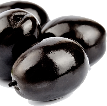







Dough recipe? Think in percentages!

 3464 x views
3464 x views
That's perfectly understandable, but with this question, you're making things harder than necessary for yourself as a beginner pizza maker. After all, some people like their pizza soft and airy, while others prefer it nice and crispy. So, there's no guarantee that just any recipe from someone else will give you The Perfect Pizza.
It helps to have a clear idea of what you want to whip up in your oven. This allows you to work much more precisely towards your personal, customized dough recipe. It might sound complicated, but trust us: it's really not that bad.
Pizza dough requires 4, maximum 5 ingredients:
- Flour (or a combination of both)
- Water
- Yeast
- Salt
- Olive oil (optional)
For most pizza styles, the first 4 ingredients are identical. Only the oil ingredient is at the pizza maker's discretion. Neapolitan pizza is never made with oil. Other styles often use oil. We'll explain why later when we examine the ingredients.
So, in our opinion, the secret to The Perfect Pizza isn't so much in this list of ingredients. Sure, you can use flour from mill A or mill B, and there will be slight differences. But it's still flour. The fact remains that every pizza maker uses the same list of ingredients.
So, it's all about how you use these ingredients. The choices you make in the quantities of each ingredient set the tone for how your pizza comes out of the oven.
You need to know what possibilities the ingredients offer you. You have to discover their connections. And understand how to vary and adjust. That's The Game of the Elements. We'll explain the rules.
Think in percentages
The most important rule when it comes to making dough is: think in percentages. The ingredients for pizza dough are always calculated in specific proportions to each other. These are the proportions:
FLOUR = 100%
WATER = 53-80%
DRY YEAST = 0,1% tot 0,4%
SALT = 1,5% tot 3%
OIL = 1% tot 3%
This is essentially a framework for calculating your personal dough recipe. It might seem a bit cryptic, but it's surprisingly simple:
-
For each ingredient, you'll convert the percentages to grams.
-
The margin you see in the percentages is your "wiggle room" as a pizza baker.
-
You could choose a 53% hydration, but you could also go for 60% water. Or 80%.
-
The choice you make naturally has a certain effect. That's the art.
Here's how to calculate your recipe:
- The amount of flour is always the starting point for your dough recipe. The amount of flour is also always 100%.
- Convert this percentage to grams. If you're working with 1 kilo of flour, 100% is 1,000 grams. If you're working with 250 grams of flour, that 250 grams of flour is 100%.
- Calculate all other ingredients relative to the amount of flour in grams. If you choose 55% water, you'll need 550 grams of water (55% per 1,000 grams of flour = 550 grams).
- If you use 500 grams of flour instead of 1,000 grams, then 55% water is 275 grams of water (0.55 x 500).
- 1.5% salt per 1,000 grams of flour = 15 grams of salt. 2% salt per 1,000 grams of flour = 20 grams of salt.
Because you calculate with percentages, your recipe is scalable. So it doesn't matter whether you want to make 1 or 2 balls of dough, or 400. You calculate the required quantities for each ingredient, and the result is your customized dough recipe.
There are several apps available these days that take care of this calculation for you. Our Perfect Pizza Flours app also has a calculator. Essentially, the apps work the same way: you enter the desired number of dough balls, along with a few other variables, and the app calculates your recipe. Convenience is key.
And yet, we believe it's important that you understand the system behind the calculation. Most apps are nothing more than a calculation tool. Convenient, but the app simply calculates what you enter. If you don't know what 70% water means in your dough, you can blame the app for your dough being sticky... but that's really the fault of the pizza maker on duty, not the app.
Because certain percentage choices can lead to undesirable effects, we'll go through the ingredients one by one so you understand the role they play in your dough.
Flour
We will cover all aspects of your flour in different blogs on this website.
Water
Flour and water together form the core of your pizza dough. Flour provides the gluten needed to trap air in your dough and give it elasticity.
Water is a vital link in the formation of the gluten network. While flour plays the most decisive role in dough formation, water is the most controlling of all ingredients. The amount of water largely determines how your pizza will turn out: airy or crispy.
Do you like a crispy pizza? Then make dough with, for example, 53 to 55% water. If you prefer the Neapolitan style, you need 56 to 60% water. Do you want very airy dough with large air bubbles, like in an Italian ciabatta? Then you need at least 70% water.
Around 60% water is a tipping point for many pizza flours. Above 60% water, your dough can quickly become wetter (and stickier). This makes it more difficult to round out your dough. If you want to be on the safe side when it comes to handling your dough, stick to a maximum of 60% water.
The amount of water in your dough always depends on your oven and the baking temperature. Bake at a lower temperature, and your pizza will bake longer and will generally be crispier. A light and fluffy pizza is usually baked briefly at a higher temperature.
To demonstrate that The Perfect Pizza is sometimes a matter of details: In one oven, 53% water in your dough will result in a deliciously crispy pizza. In another oven, the dough with the same percentage of water might become as hard as a cracker. So you have to experiment to find what works best for you and what the ideal percentages are.
Our tip regarding water: start with 60%; this almost always produces a good pizza. You can always increase or decrease the water percentage later.
Yeast
We prefer to use dry yeast or instant yeast (the small granules), simply because these types have a much longer shelf life than fresh yeast. You won't notice any difference in taste between the two because the yeast strain is the same: Saccharomyces cerevisiae.
If you prefer to use fresh yeast, it's good to know that it's less potent than dry yeast. The ratio is 3:1, meaning: 3 grams of fresh yeast equals 1 gram of dried yeast. In the percentages mentioned, from 0.1% to 0.4%, we assume dry yeast is used. Do the calculation and multiply the result by 3 if you're using fresh yeast.
Yeast is a difficult ingredient to summarize in a few words. You have to develop a feel for the right amount for you, your recipe, and your working method, and that can only really be achieved through practice.
We will, of course, provide some guidance. For example, the amount of yeast depends on the resting time of your dough
and the ambient temperature.
- The longer the proofing, the less yeast: > 0.1%-0.2% for proofing longer than 8 hours.
- Use less yeast at an ambient temperature higher than 22°C (72°F). > 0.1%.
- Use slightly more yeast at a lower ambient temperature: > 0.2%-0.3%.
- If your dough is refrigerated for more than 24 hours, use slightly more yeast: > 0.2%.
- For very short proofing times (less than 8 hours), use more yeast: > 0.3%-0.4%.
The ultimate yeast percentage
Do you never want to have to worry about the amount of yeast again and still make perfect dough 95% of the time? Then use 0.2% dry yeast. That's usually fine.
Dry yeast versus instant yeast
These two variants are not entirely the same. Dry yeast sometimes needs to be activated in lukewarm water before you can use it further in your dough. Instant yeast can be used immediately. However, these days, you can usually use dry yeast immediately.
Storing Yeast
Store dry yeast in a sealed container in the refrigerator for a long shelf life. It won't spoil quickly; at most, its effectiveness will diminish slightly over time. You can compensate for this by using a little more yeast.
Testing Yeast
If you suspect your yeast is no longer active, dissolve some yeast in a little lukewarm water with a little honey or sugar. The mixture should foam, a sign that the yeast is still active. No foam? Then it's better to replace the yeast with fresh yeast.
Salt
You need salt to make good dough. Salt plays a more important role in your dough than you might expect:
- Salt ensures good water absorption.
- It influences gluten formation and strengthens the gluten network, which traps air during fermenting.
- Salt affects the volume of your dough and adds color to it when baking.
- Salt makes your dough crispier and adds flavor.
- On warm days, adding more salt can slow the proofing process.
We both almost always make our dough with 2% salt. That's considerably less than the 3% salt in the Neapolitan dough recipe, but sufficient for a very tasty dough.
We prefer to use fine sea salt because it dissolves easily, but coarse sea salt or rock salt will also work.
If you want to reduce the salt, you can lower the percentage to 1%. Even less salt, or even saltless dough, is technically possible—you'll still be making dough—but keep in mind that your dough will tear much more easily when shaping the crust.
Oil
Adding oil to your pizza dough is a choice. It has advantages, but sometimes it's better not to add any oil at all.
In the past, before the advent of electric ovens, no fats were added to pizza dough at all. Because baking times in electric ovens used to be longer than in wood-fired ovens, pizza makers noticed that their electric-baked pizzas sometimes turned out too dry. That's when the idea of adding oil to pizza dough arose:
- Oil binds to the starch, slowing moisture evaporation; this makes the pizza more brittle.
- Oil creates a softer crumb and makes it lighter.
- Oil is a good heat conductor, giving the pizza a beautiful golden brown color when baked.
- The pizza also stays warm longer once it's out of the oven.
- Oil helps form the gluten network in your dough and promotes the rising process.
If you want to add oil, olive oil is the most obvious choice. Most Italian pizza makers will choose olive oil. In that case, preferably use extra virgin olive oil, as this is the highest quality, first-pressed oil.
Another option is peanut oil. Adding peanut oil to your dough will result in a crispier, less soft pizza. Olive oil, on the other hand, will make your pizza a bit more brittle.
You can also replace olive oil with other vegetable oils such as sunflower, corn, or canola. Whichever oil you use, don't exceed 3%, as your dough will be too greasy.
Finally, a tip for when it's best not to add oil to your dough: when you're baking your pizza at a high temperature above 400 degrees Celsius. In the past, these high temperatures were mainly achieved in a wood-fired oven. But nowadays, electric pizza ovens are also available that can reach temperatures above 450 degrees Celsius. Because of the high temperature and the fact that oil conducts heat, you run a higher risk of burning your dough.
For the meticulous among us: we calculate the amount of oil to add in grams. But the specific gravity of oil is 0.92, which means that 100 ml of oil weighs 92 grams. Let's record this as a rounding difference. Our pizzas have certainly never failed because of this.




 0
0